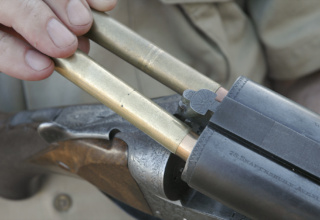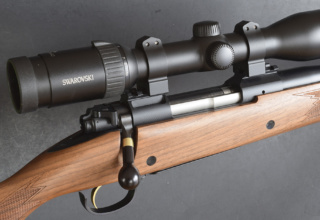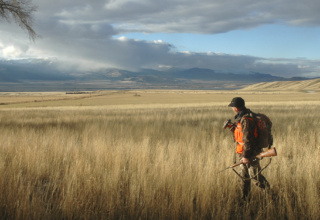When the .22 rimfire emerged from the primordial mists of the 1850s, hunters had no hotrod .22 centerfires. Heck, there were no hotrods, because cars hadn’t been invented. The Henry rifle in .44 rimfire had yet to evolve into Oliver Fisher Winchester’s first repeater. Verily, Winchester was still a shirt-maker, contemplating purchase of a bankrupt gun project.
About 30 years later, after Winchester had gained traction as a company and produced the Models 1866 and 1873 (the latter in .22 rimfire), Utah firearms genius John Browning began sending his designs to New Haven. Meanwhile, Winchester chambered its single-shot Model 1885 (a Browning invention) to the .22 WCF, a new cartridge pushing 45-grain bullets at 1,500 fps. Slightly more powerful than high-speed .22 Long Rifle loads now, it out-ran the first LR ammo in 1887 and sparked an industry in .22 centerfires.

They didn’t hit their stride until smokeless powder appeared in the 1890s. Charles Newton came up with the .22 Hi-Power for Savage 1899 rifles in 1912. Based on the .25-35 case, it launched 70-grain .228 bullets at 2,800 fps, eclipsing the fastest big game rounds of the day. In fact, it was used abroad on animals as tough as tigers! Hunters who limited the Hi-Power to smaller game had better odds of using it longer. Newton followed with a .22 on a chopped .30-06 hull. It drove 90-grain .228s at 3,100 fps.
During the 1920s, wildcatters fashioned a modern version of the .22 WCF. It appeared in factory-loaded Winchester ammo in 1930 as the .22 Hornet. A spate of other fast .22s followed in 1930s: the .218 Bee and .219 Zipper for lever-actions that couldn’t tap their potential, the .220 Swift that hurled 45-grain bullets at 4,000 fps, the .22-250, a .250 Savage-based wildcat that would wait until 1965 for commercial adoption by Remington. After WW II the .222 (1950), .223 and .222 Magnum (1957 and 1958) enriched the smallbore field. The .22 Jet, a handgun cartridge from Remington and Smith & Wesson, appeared in 1961. Weatherby announced its .224 Magnum two years later, as did Remington the .221 Fireball. The .225 Winchester followed in ‘64. Germans added the 5.56×50 Magnum in 1968. U.S. Benchrest shooters Ferris Pindell and Lou Palmisano reduced the taper of the .220 Russian in 1974 to form the .22 PPC. This long series of cartridges all used now-standard .224-diameter bullets.
New options in .22 centerfires were absent most of three decades. Then in 2002, the speedy .223 Winchester Super Short Magnum made its debut. Two years later Ruger nudged shooters to re-think the 20 caliber with its .204. The .22 Nosler, a 2016 development, is the most recent of the .22 centerfire clan.
 For hunting “varmints” – commonly foxes, coyotes and groundhogs – or picking prairie dogs off mounds shimmering in distant mirage, the aging .22-250 and .220 Swift still excel. But for most shots, the gentler .222 Remington and kin work fine. The .225’s rimmed case is a perfect match for dropping-block single-shots. When cost, availability and variety matter, the .223 wins. Its adoption by the U.S. Army as the Ball Cartridge M193 in 1964 (now the 5.56 NATO) promised piles of ammo.
For hunting “varmints” – commonly foxes, coyotes and groundhogs – or picking prairie dogs off mounds shimmering in distant mirage, the aging .22-250 and .220 Swift still excel. But for most shots, the gentler .222 Remington and kin work fine. The .225’s rimmed case is a perfect match for dropping-block single-shots. When cost, availability and variety matter, the .223 wins. Its adoption by the U.S. Army as the Ball Cartridge M193 in 1964 (now the 5.56 NATO) promised piles of ammo.
Incidentally, there are differences between the 5.56 NATO and the .223. When Remington began barreling for the .223, it could have stayed with 5.56 chamber dimensions. Instead, it specified a shorter throat (freebore ahead of the chamber) and steeper leade (angle of the lands, groove to bore diameter, in front of the throat). Reason: In battle the NATO didn’t have to yield the accuracy hunters expected of the .223. Soldiers preferred reliability in harsh conditions with dirty ammo and long tracer bullets. Generous chambers also kept stiff military loads from hiking pressures above red-line when sustained fire brought barrels to bar-b-q temperatures. Hunters craved snug chambers and minimum throats. Case dimensions for the two cartridges are identical. But ballisticians point out that the .223 is loaded to a SAAMI pressure of 55,400 CUP (Copper Units of Pressure). Service loads for the 5.56×45 NATO generate 58,500. You can expect 5.56 barrels to have .125 more freebore than those in .223.

If you’re a .22 rimfire fan like me, you’ll spare yourself the angst of choosing between loud and louder cartridges, the certainty that your barrel will burn out before the next Presidential election, despair as prices of cases, bullets and powder climb. You needn’t pilfer Junior’s college fund for a bolt rifle that bottles 65,000 psi or a scope to show you targets as far as spitzers started at Mach 4 will reach.
Rimfire rifles cost less than centerfires, but within their range limits shoot as accurately. You’ll not need ear protection outdoors to fire .22 LRs from rifles (though plugs are a good idea). You can put 100 upscale .22 rimfire loads to work for the price of 20 centerfires. Scope mounts for grooved receivers are inexpensive, and you won’t even want a 3-pound 34mm optic astraddle a lithe .22 rifle.
Beyond the noise and expense of centerfires is their destructiveness in game. Tree squirrels and rabbits that first drew me afield – and that still woo youngsters – are properly taken with .22 rimfires. LR hollow points ensure humane kills with body hits but won’t with a rib shot mince the entire animal.

Nowhere do I find more of hunting’s magic than under an October beech as night’s sky blushes pink and crows give cry to a new morning. Listening for the first rustle of treetop leave or the first nut to drop, I’m as fully engaged as when trailing a leopard in tall grass or facing Cape buffalo at spitwad range. On a crisp December dawn, oblique sunbeams skating across stubble to set the snow a-sparkle, the next rabbit cover pulls me as surely as the bray of a bull elk from black timber or the silent promise of rams in meadows fringing the crags.
Fast and loud once appealed to me, in music, motorcycles and automobiles as well as in firearms. Both still have a place. Rimfire rifles or centerfire? My rack holds both. The centerfires collect more dust












